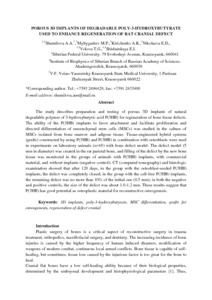Показать сокращенную информацию
Porous 3D implants of degradable poly-3-hydroxybutyrate used to enhance regeneration of rat cranial defect
| Автор | Шумилова, Анна Алексеевна | |
| Автор | Мылтыгашев, Мирген Прокопьевич | |
| Автор | Кириченко, Андрей Константинович | |
| Автор | Николаева, Елена Дмитриевна | |
| Автор | Волова, Татьяна Григорьевна | |
| Автор | Шишацкая, Екатерина Игоревна | |
| Дата внесения | 2018-02-07T07:28:34Z | |
| Дата, когда ресурс стал доступен | 2018-02-07T07:28:34Z | |
| Дата публикации | 2017-02 | |
| Библиографическое описание | Шумилова, Анна Алексеевна. Porous 3D implants of degradable poly-3-hydroxybutyrate used to enhance regeneration of rat cranial defect [Текст] / Анна Алексеевна Шумилова, Мирген Прокопьевич Мылтыгашев, Андрей Константинович Кириченко, Елена Дмитриевна Николаева, Татьяна Григорьевна Волова, Екатерина Игоревна Шишацкая // Journal of Biomedical Materials Research - Part A. — 2017. — Т. 105 (№ 2). — С. 566-577 | |
| ISSN | 15493296 | |
| URI (для ссылок/цитирований) | http://onlinelibrary.wiley.com/doi/10.1002/jbm.a.35933/abstract | |
| URI (для ссылок/цитирований) | https://elib.sfu-kras.ru/handle/2311/69804 | |
| Описание | Текст статьи не публикуется в открытом доступе в соответствии с политикой журнала. | |
| Аннотация | The study describes preparation and testing of porous 3D implants of natural degradable polymer of 3-hydroxybutyric acid P(3HB) for regeneration of bone tissue defects. The ability of the P(3HB) implants to favor attachment and facilitate proliferation and directed differentiation of mesenchymal stem cells (MSCs) was studied in the culture of MSCs isolated from bone marrow and adipose tissue. Tissue-engineered hybrid systems (grafts) constructed by using P(3HB) and P(3HB) in combination with osteoblasts were used in experiments on laboratory animals (n=48) with bone defect model. The defect model (5 mm in diameter) was created in the rat parietal bone, and filling of the defect by the new bone tissue was monitored in the groups of animals with P(3HB) implants, with commercial material, and without implants (negative control). CT (computed tomography) and histologic examination showed that after 120 days, in the group with the osteoblast-seeded P(3HB) implants, the defect was completely closed; in the group with the cell-free P(3HB) implants, the remaining defect was no more than 10% of the initial one (0.5 mm); in both the negative and positive controls, the size of the defect was about 1.0-1.2 mm. These results suggest that P(3HB) has good potential as osteoplastic material for reconstructive osteogenesis. | |
| Тема | 3D implants | |
| Тема | poly-3-hydroxybutyrate | |
| Тема | MSC differentiation | |
| Тема | grafts for osteogenesis | |
| Тема | regeneration of defect cranial | |
| Название | Porous 3D implants of degradable poly-3-hydroxybutyrate used to enhance regeneration of rat cranial defect | |
| Тип | Journal Article | |
| Тип | Journal Article Preprint | |
| Страницы | 566-577 | |
| ГРНТИ | 34.57.21 | |
| Дата обновления | 2018-02-07T07:28:34Z | |
| DOI | 10.1002/jbm.a.35933 | |
| Институт | Институт фундаментальной биологии и биотехнологии | |
| Подразделение | Кафедра медицинской биологии | |
| Подразделение | Базовая кафедра биотехнологии | |
| Журнал | Journal of Biomedical Materials Research - Part A | |
| Квартиль журнала в Scopus | Q1 | |
| Квартиль журнала в Web of Science | Q2 |

